More commonly consumer-oriented zoom lenses feature what’s known as a “variable maximum aperture,” meaning that the maximum amount of light the lens can transmit reduces as you zoom in. This helps keep the size, weight and cost of a zoom realistic for use on smaller DSLRs such as the D3400, but often affects performance — most notably light transmission and low-light performance, which have a significant bearing on a lens’s overall DxOMark score.
That said, there are some great zoom lenses available for the D3400, and we’ve tested a total of 47, covering focal lengths from an ultra-wide 8mm through to a super-telephoto 300mm. To make the analysis as digestible as possible, we round up the verified results in five categories: wide-angle, standard, DX telephoto, FX telephoto, and super-zoom, and consider the results of the top performers in each group.
Best wide-angle zoom: Tokina AT-X 14-20mm f/2 PRO DX
Wide-angle zooms offer a range of focal lengths from an ultra-wide through to a standard-wide field of view, making them a popular choice for landscape and architectural photography, or for simply shooting in restricted spaces with the D3400. All wide-angle zooms in this category are DX-mount lenses, meaning that they’ve been specifically designed for use on APS-C Nikon cameras such as the D3400, but are not compatible with Nikon full-frame DSLRs. We’ve tested a total of eight wide-angle zooms on the D3400, with scores ranging from a high of 26 points for the Tokina AT-X 14-20mm f/2 PRO DX to a low of 11 points for the Sigma 10-20mm f/4-5.6 EX DC.
The top three performers are all from third-party manufacturer Tokina, with each offering slightly different specifications. At the top of the tree, the Tokina 14-20mm f/2 has a slightly limited zoom range and doesn’t offer the same ultra-wide field of view as its counterparts. The advantage of this construction, however, is that the $599 Tokina 14-20mm f/2 boasts a wider maximum f/2 aperture that improves its light transmission, which could be an important factor if you’re looking for a wide-angle zoom predominantly for low-light photography.
Scoring 16 P-Mpix for sharpness, resolution on the Tokina 14-20mm f/2 is a notable step up from the 11 P-Mpix achieved by both the $563 Tokina 11-20mm f/2.8 and the $444 Tokina 11-16mm f/2.8 alternatives.
The sharpness P-Mpix map shows that the Tokina 14-20mm f/2 is both sharper and more consistent across the various aperture and focal length settings compared to its f/2.8 counterparts, and that it delivers excellent resolution between f/2.8 and f/8. The Tokina 14-20mm f/2 also handles chromatic aberration, or fringing, much better than its rivals, which display some fairly heavy fringing at the wider focal lengths using all apertures, but improve a little at the longer focal lengths.
All three top Tokina performers display some barrel distortion at the wider focal lengths, and vignetting at the maximum apertures, but this isn’t uncommon with lenses of this type, and these adverse effects can often be adequately corrected in post-production.
Best standard zoom: Sigma 18-35mm f/1.8 DC A
A standard zoom lens offers a wide-angle through to short-telephoto focal length in a single lens, which makes them a convenient choice for a range of subjects, such as landscape and portrait photography. The typical standard zoom range for DX-format lenses used on APS-C sensor cameras is 18-55mm, which is the lens often supplied as part of the basic lens kit.
To keep the cost of these kit lenses as low as possible, the basic 18-55mm lens is a rather lightweight option, featuring a variable f/3.5-5.6 maximum aperture, and they aren’t renowned for great optical performance. If you’re looking for a standard zoom lens for the D3400 that offers better image quality, there are a number of fixed f/2.8-aperture alternatives that achieve better overall scores, thanks to their improved low-light performance and sharper results. We’ve tested 16 standard zoom lenses on the D3400, with scores ranging from a high of 30 points for the Sigma 18-35mm f/1.8 A to a low of 13 points for the Nikon 17-35mm f/2.8D, and we’ve included the top ten in the table below.
Keen-eyed observers will have noted that the top two performers from Sigma both offer a shorter zoom range of either 18-35mm (27-52mm equivalent) or 24-35mm (36-52mm equivalent). The shorter zoom range has enabled Sigma to utilize a wide maximum aperture — either f/1.8 or f/2 — which has significantly improved these lenses’ low-light performance. Both are part of Sigma’s high-performance Art range and offer great optical quality, achieving the sharpest results in this category, but obviously they’re not quite as versatile in terms of their zoom range as a typical standard zoom; for this reason, we’ve decided to analyze their performance separately.
The $799 Sigma 18-35mm f/1.8 DC A is a lens specifically designed for use on APS-C sensors, as opposed to the $899 Sigma 24-35mm f/2 A, which is a full-frame, or FX-mount, lens that remains compatible with the D3400.
Producing an image circle much larger than the APS-C sensor, the Sigma 24-35mm offers favorable results for distortion, vignetting, and chromatic aberration compared to the Sigma 18-35mm, as the D3400’s smaller APS-C sensor doesn’t record the more problematic parts of the image circle — the corners —when using the 24-35mm FX lens. With an equivalent 36-52mm focal length, the Sigma 24-35mm f/2 A doesn’t offer much of a wide-angle field of view on the D3400, but remains a useful focal length for general use and for portraits.
The Sigma 18-35mm f/1.8 A, dedicated for APS-C, is the much better option for D3400 shooters, however. Not only does it offer a more versatile focal range, sharpness is improved — with very strong resolution at all focal lengths between f/1.8 and f/8; and it costs $100 less than the FX-mount Sigma 24-35mm f/2 A, too.
If you want the extra reach that the typical standard zoom focal range offers, we’ve picked out three of the best-performing 17-50/55mm options, including the $399 Sigma 17-50mm f/2.8 with 21 points, the $499 Tamron 17-50mm f/2.8 Di II and the $1497 Nikon 17-55mm f/2.8G, both with 18 points.
The third-party Sigma and Tamron options boast an improved overall sharpness of 14 P-Mpix on the D3400, compared to 7 P-Mpix for the Nikon. You can see from the sharpness P-Mpix map below that the third-party lenses, and the Sigma specifically, offer significantly improved resolution at all focal lengths using apertures between f/2.8 and f/8, as indicated by the green sections on the map.
The Tamron offers a smaller minimum aperture of f/32 (compared to f/22 on the Sigma and Nikon), and slightly sharper results at this setting, which could be important if you’re predominantly interested in landscape or longer depth-of-field shots, but for most photographers, improved performance at the maximum apertures is paramount. The Tamron 17-50mm also offers less chromatic aberration compared to its rivals, and particularly against the Nikon 17-55mm, which displays some fairly heavy fringing on RAW files, although it’s only fair to point out that this is often adequately corrected in-camera when shooting JPEGs, and can often be removed from RAW files in post-production, too.
Best DX telephoto zoom: Sigma 50-150mm f/2.8 DC
A telephoto zoom is a popular second lens choice for many photographers looking for an optic with a longer focal length for zooming in closer on distant subjects when shooting sports and wildlife. Again, there are both APS-C-specific DX-mount options alongside the bigger and heavier FX-mount alternatives that remain compatible with the D3400.
In DX format, the typical standard zoom focal length is 55-200mm (82-300mm equivalent), and these lenses commonly feature a variable f/4-5.6 maximum aperture that helps keep the size, weight, and cost down, but reduces the amount of available light for the viewfinder and autofocus system. The amount of magnification a telephoto zoom offers at the long end of the zoom means you will need fairly fast shutter speeds to prevent images from looking blurry. Image stabilization can help with this, as it can effectively correct some minor camera shake when using long focal lengths. It’s definitely a feature worth looking out for on telephoto zoom lenses, and each manufacturer has their own name for their system, such as Vibration Reduction (VR) on Nikon, Optical Stabilization (OS) on Sigma, and Vibration Compensation (VC) on Tamron. We’ve tested five DX-format telephoto lenses on the D3400, with scores ranging from a high of 25 points for the Sigma 50-150mm f/2.8 DC, to a low of 12 points for the Nikon 55-200mm f/4-5.6G.
The top-ranked Sigma 50-150mm f/2.8 DC is now discontinued as Sigma focuses its efforts on the new $1099 Sigma 50-100mm f/1.8 DC Art lens, which we haven’t yet tested on the D3400. If you can pick up a Sigma 50-150mm f/2.8 DC in good condition second-hand, however, it’s an excellent telephoto zoom for the D3400, thanks to its fixed f/2.8 aperture, good light transmission, and excellent sharpness, with high levels of resolution at all apertures between f/2.8 and f/8.
Bear in mind, however, that the fixed f/2.8 aperture makes the Sigma significantly bigger and heavier than a typical 55-200mm lens, and indeed, it weighs over four times as much as the Nikon 55-200mm f/4-5.6.
Nikon’s own $147 55-200mm f/4-5.6G VR II is also a very affordable alternative, which delivers surprisingly good performance despite the cheap price point. Overall sharpness is a step down from the Sigma, but it still produces good resolution between 55-135mm using apertures up to f/8. Light transmission on the Nikon 55-200mm f/4-5.6G VR II remains fairly consistent from 55mm to 135mm, too, but reduces significantly from 135mm to 200mm, which means you’re going to need some pretty decent light for good performance at the long end of the zoom.
Best FX telephoto zoom: Tamron SP 70-200mm f/2.8 Di VC
FX-format telephoto zooms designed specifically for full-frame DSLRs are still compatible with the D3400 and offer some advantages, with good light transmission and high levels of sharpness. Bigger, heavier, and more expensive than a variable-aperture DX 55-200mm f/4-5.6 lens, they’re really the preserve of photographers after the very best telephoto performance on the D3400.
The typical FX-format telephoto zoom offers a 70-200mm focal length (105-300mm equivalent), but one Sigma lens in this group features an incredible 120-300mm (180-450mm equivalent) focal length with a fixed f/2.8 maximum aperture, which provides a really long reach for sports and wildlife photography on the D3400.
We’ve tested a total of eleven FX-format telephoto zooms on the D3400, with scores ranging from a high of 24 points for the Tamron SP 70-200mm f/2.8 Di VC to a low of 15 points for the Nikon 70-300mm f/4-5.6D ED.
The top three performers include the $1199 Tamron SP 70-200mm f/2.8 Di VC with 24 points, the $2097 Nikon 70-200mm f/2.8G VR II with 23 points, and the $3399 Sigma 120-300mm f/2.8 DG OS with 22 points.
All three offer high levels of resolution at all focal lengths using apertures between f/2.8 and f/8, with the Tamron just edging it overall thanks to slightly sharper results at these settings compared to the Nikon and Sigma. These fixed-aperture telephoto zooms also offer good light transmission through their respective zoom ranges, making it easier to achieve the fast shutter speeds required for action photography; and featuring image stabilization, they’re good options for low-light telephoto shooting on the D3400, too.
Best super-zoom: Nikon 18-140mm f/3.5-5.6G ED VR
Super-zoom lenses offers a wide-angle through long-telephoto zoom range, making them a convenient all-in-one solution for photography day trips, vacations, or simply shooting a range of subjects without the hassle of changing lenses.
Facilitating all these focal lengths in one lens requires some compromises in optical construction, however, which means super-zooms aren’t the best-performing lenses for the D3400. But that’s the price you pay for convenience. The typical super-zoom focal length is 18-300mm (27-450mm equivalent), which provides a massive 17x optical zoom on the D3400. There are also some slightly shorter focal-length options in this group, such as the Nikon 18-140mm and 18-105mm alternatives, both of which rank in the top three. We’ve tested a total of ten super-zoom lenses on the D3400, with scores ranging from a high of 16 points for the Nikon 18-140mm f/3.5-5.6G ED VR to a low of 12 points for the Sigma 18-200mm f/3.5-6.3 DC OS.
The top three performers all feature a variable f/3.5-5.6 maximum aperture and similar levels of light transmission, resulting in comparable overall scores, despite their differing focal lengths. The $497 Nikon 18-140mm f/3.5-5.6G is marginally the sharpest, scoring 11 P-Mpix for resolution, compared to 9 P-Mpix for the $997 Nikon 18-300mm f/3.5-5.6G ED VR and 10 P-Mpix for the $259 Nikon 18-105mm f/3.5-5.6G ED VR.
All three produce their sharpest results at the wider focal lengths up to around 50mm using apertures up to f/8, with lower resolution at the longer focal lengths. The more versatile Nikon 18-300mm f/3.5-5.6G is just about as sharp as its shorter focal-length rivals, however, up to 105/140mm, respectively. Yes, it’s a little softer between 135mm and 300mm, but with similar sharpness and light transmission as its rivals up to 105/140mm, as well as the extra reach at the long end of the zoom, it’s a more convenient all-in-one solution for the D3400, if you can afford it.


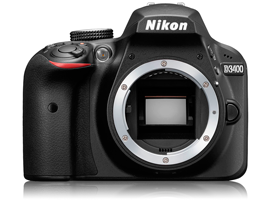
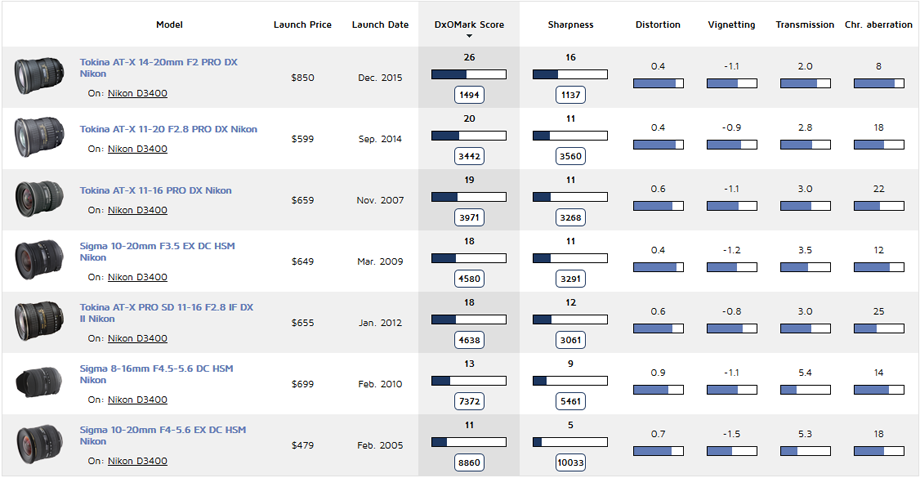
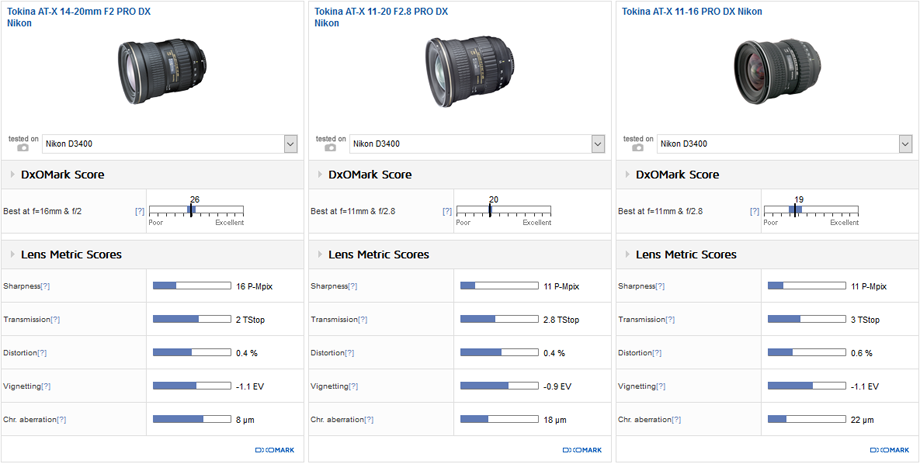
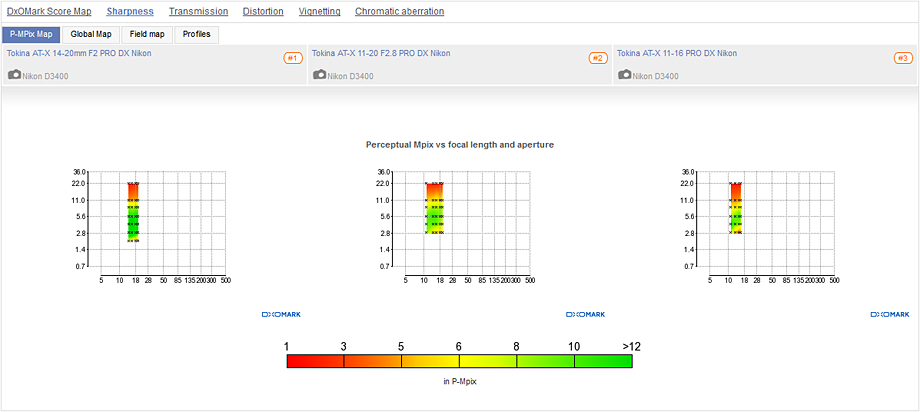
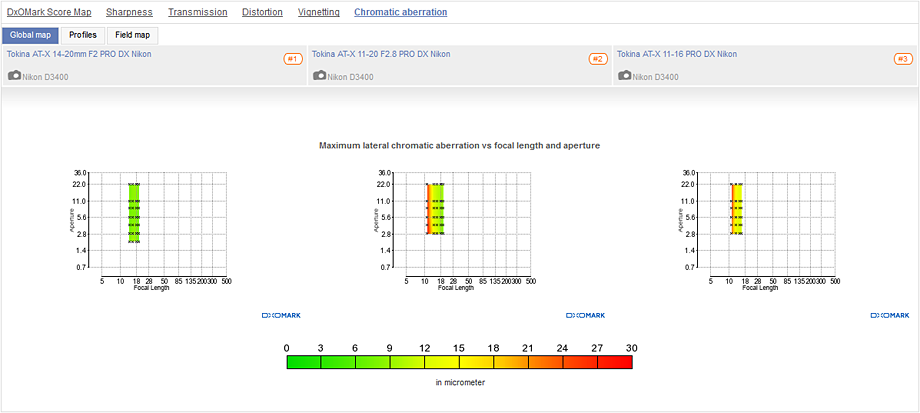

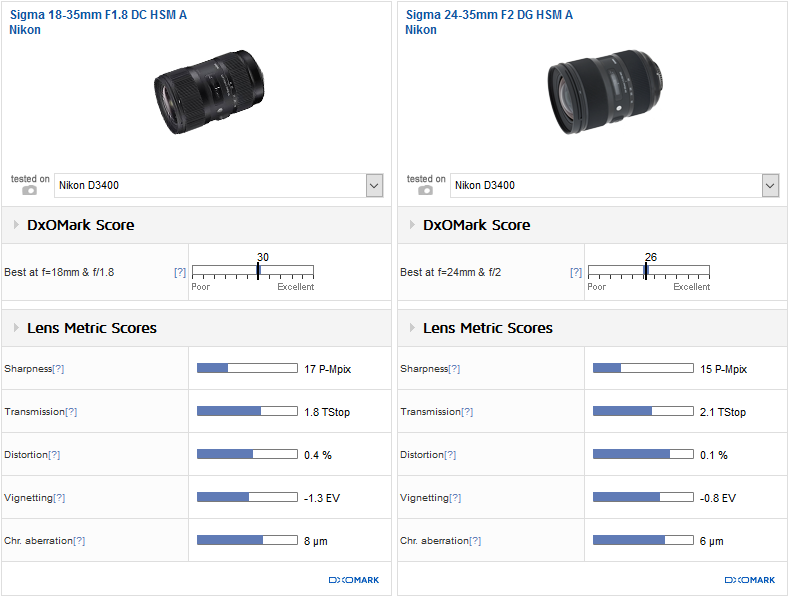
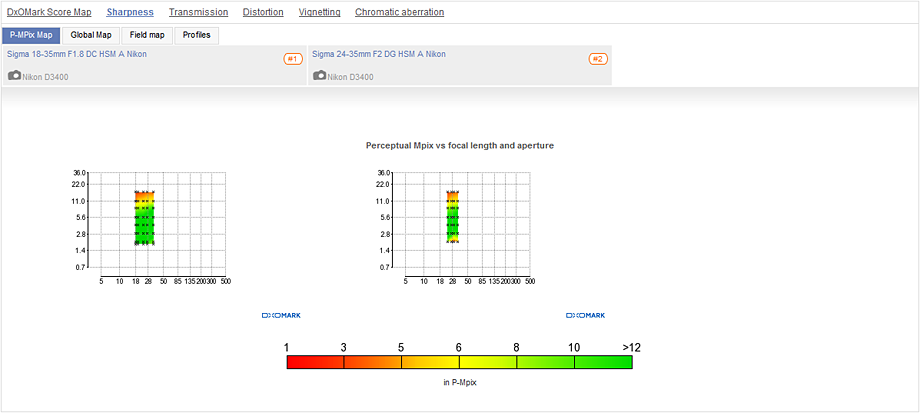
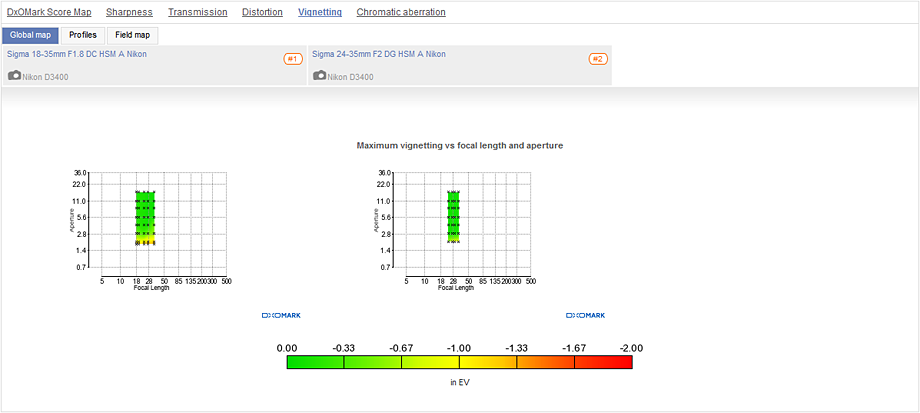



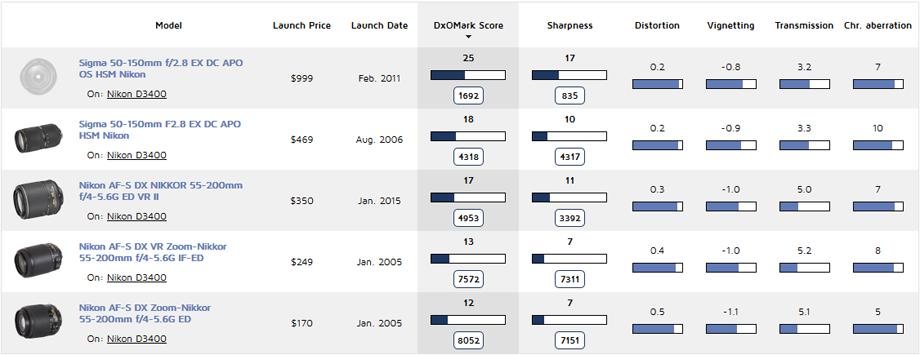

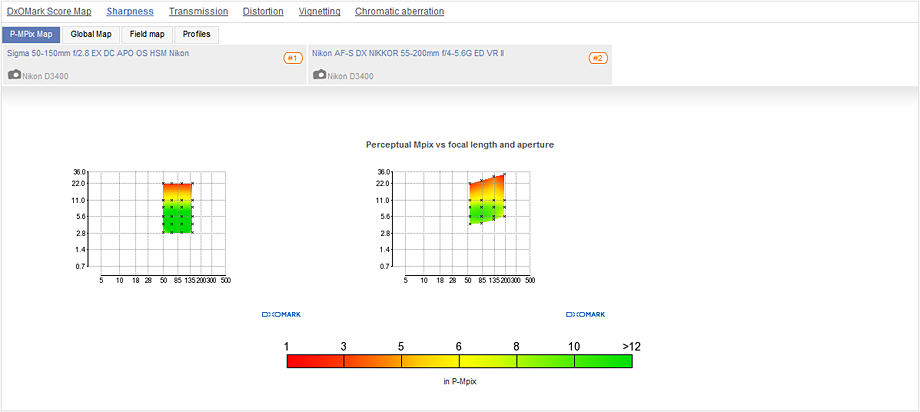
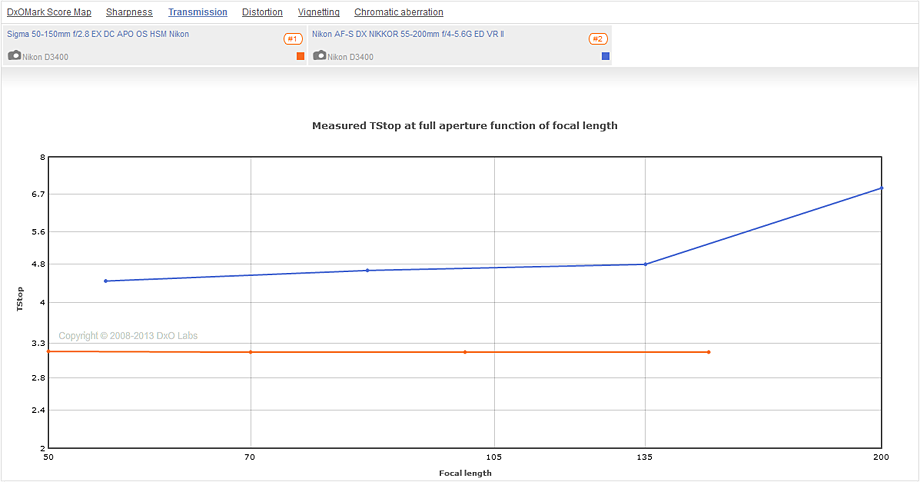
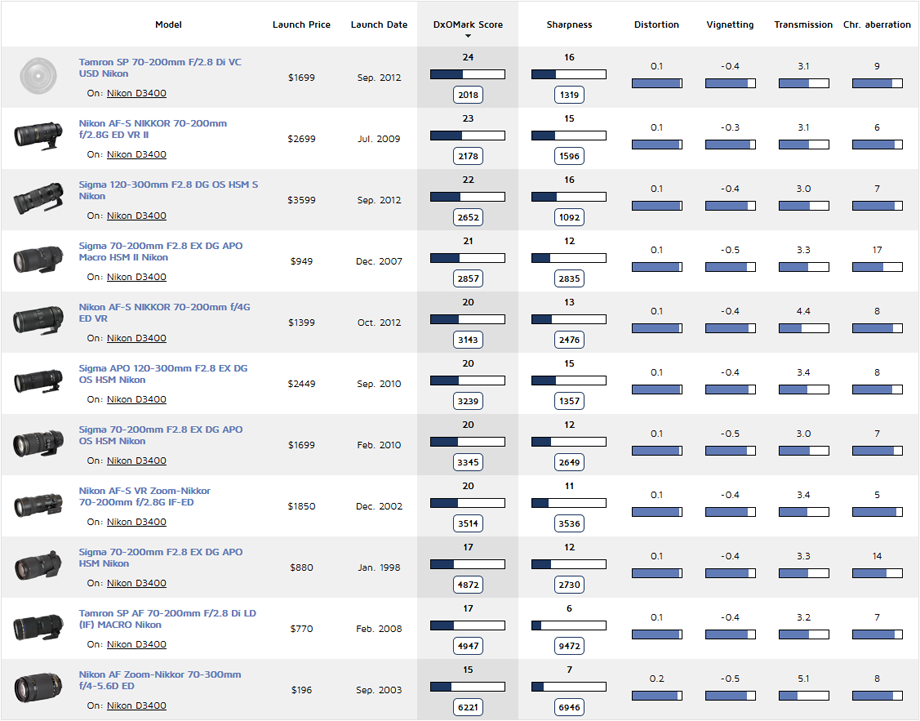
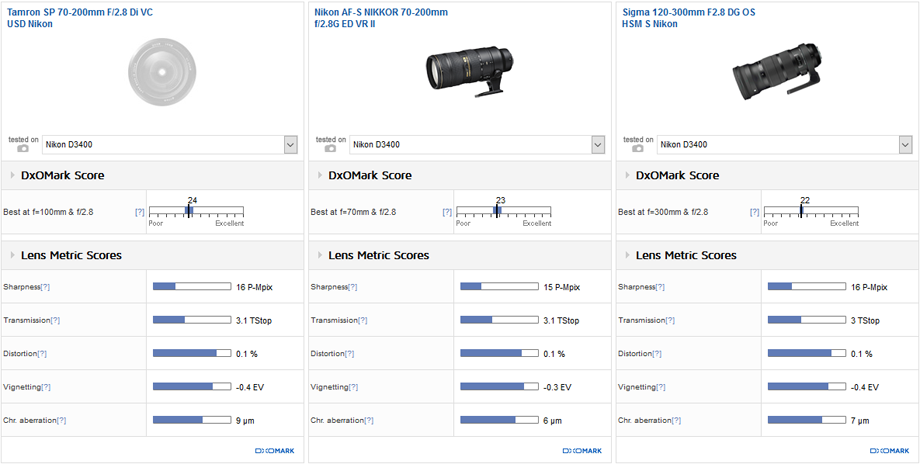
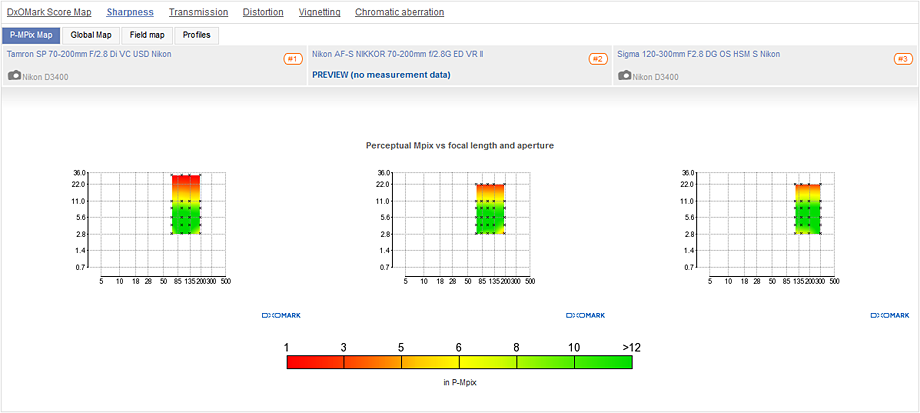
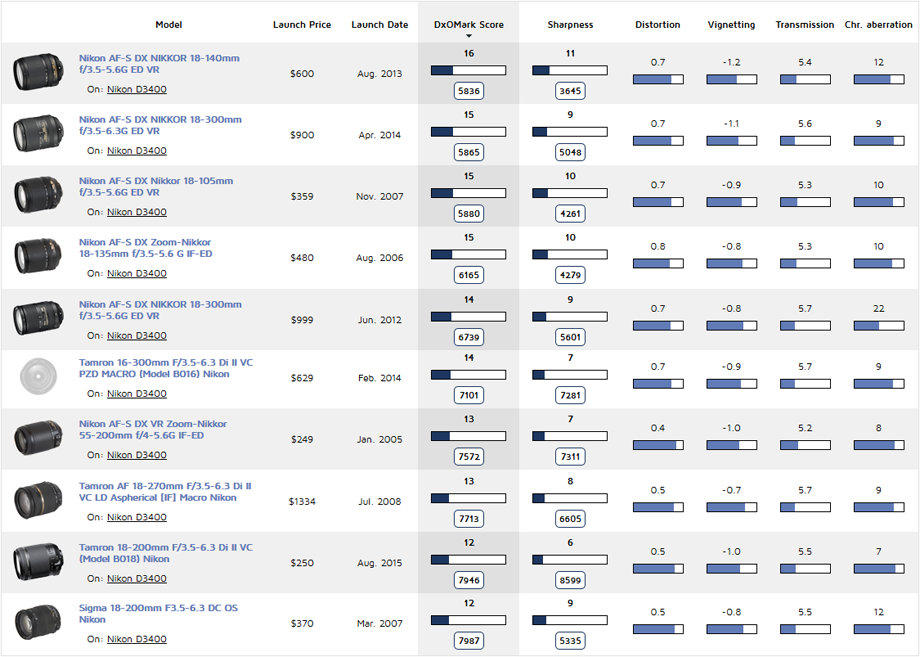
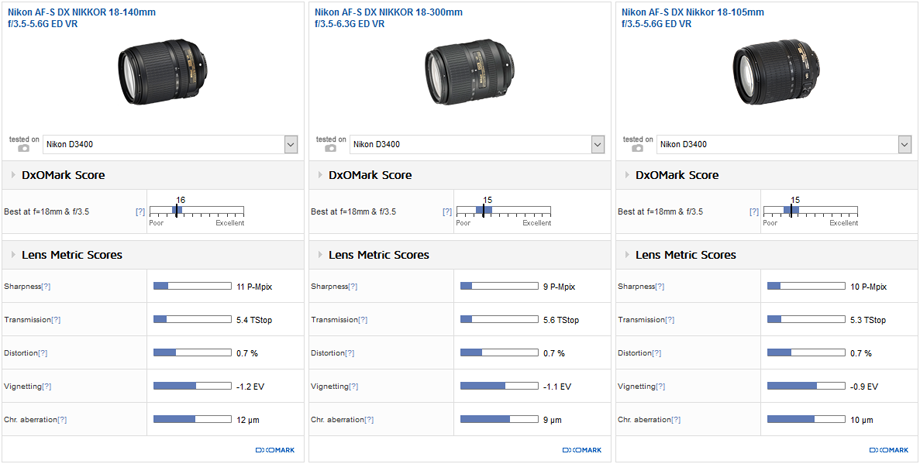


DXOMARK encourages its readers to share comments on the articles. To read or post comments, Disqus cookies are required. Change your Cookies Preferences and read more about our Comment Policy.